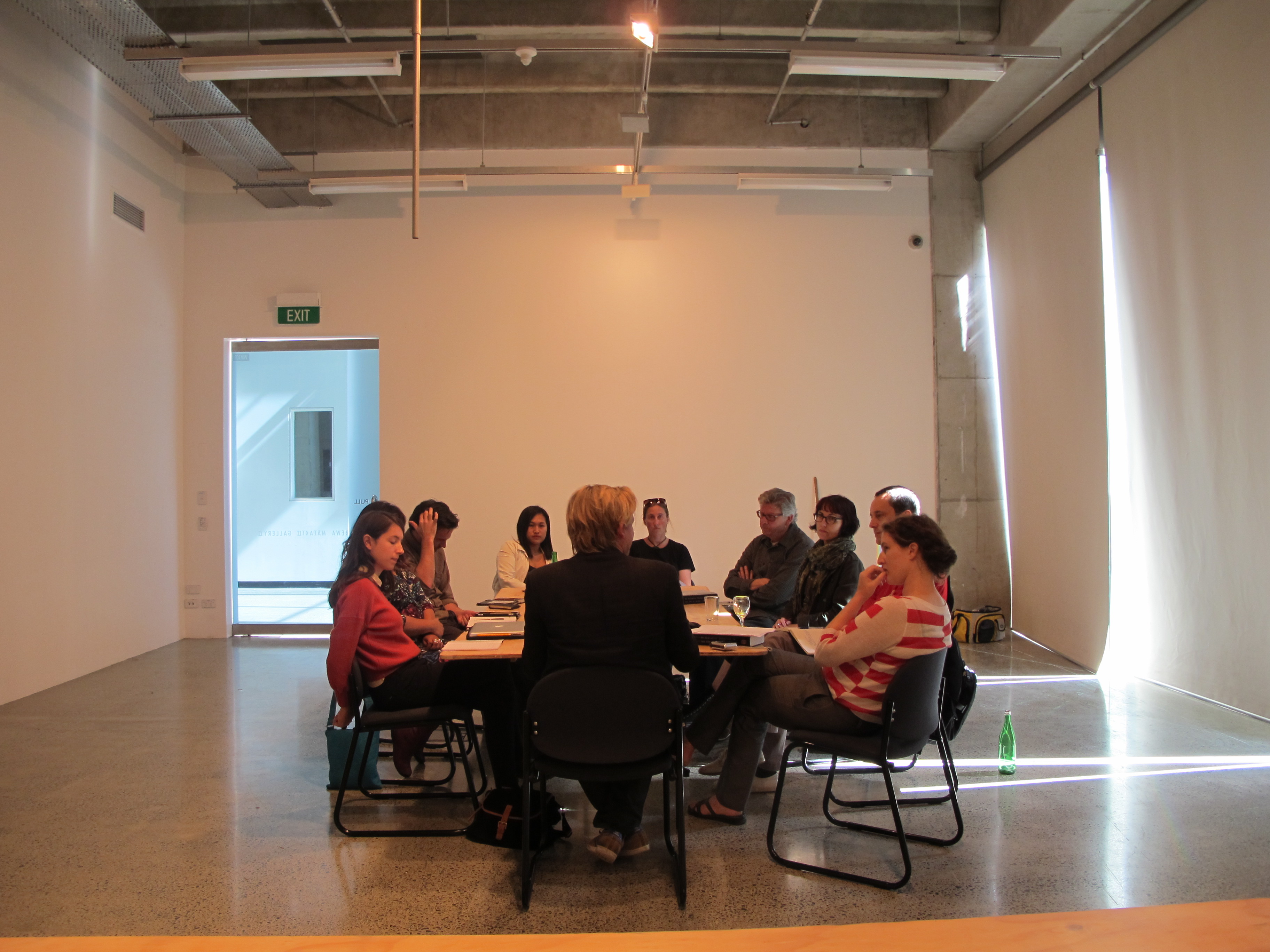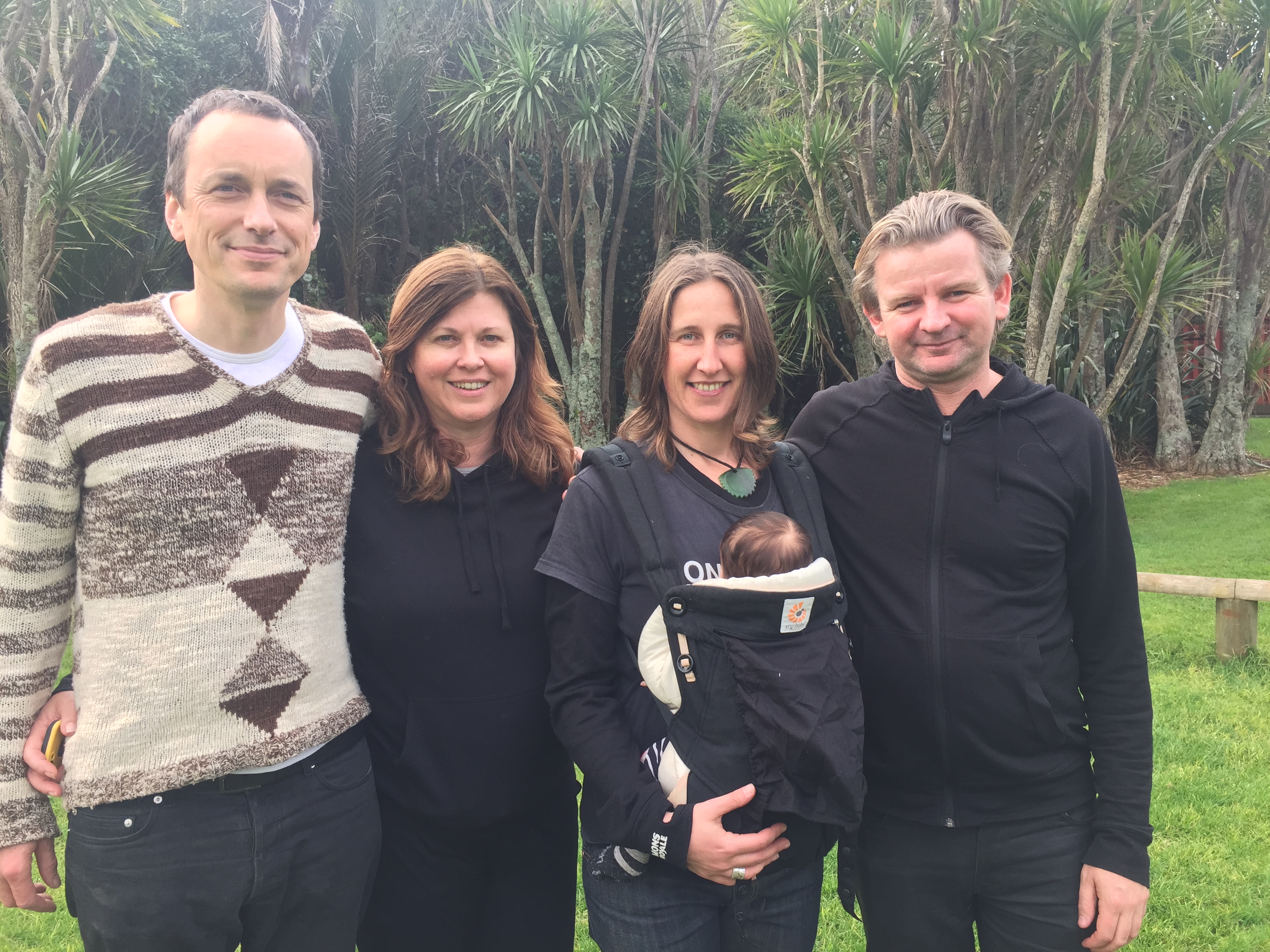But to learn to live, to learn it from oneself and by oneself, all alone, to teach oneself to live (‘I would like to learn to live finally’), is that not impossible for a living being? Is it not what logic itself forbids? To live, by definition, is not something one learns. Not from oneself, it is not learned from life, taught by life. Only from the other and by death. In any case from the other at the edge of life.
—Jacques Derrida, Specters of Marx.
Asked to write for this publication A Year of Conscious Practice alongside curator Vera Mey, who with Charlotte Huddleston on behalf of ST PAUL St Gallery offered Local Time our first gallery show in 2011, I sense an immediate and impossible call to repay a debt. Gayatri Chakravorty Spivak describes the matririn or mother-debt as an ethical concept-metaphor that speaks to the gift of being made human. Where the father-debt can be given a genealogy, a line of patrilineage, the mother-debt allows no citation and no discharge. ‘One translates this gift-into-accountability as one attempts to repay what cannot be repaid, and should not be thought of as repayable.’1 To ‘repay’ the mother-debt would be to violate the very terms of the debt: the reproduction of life itself. The mother-debt is opened toward, the debt is inhabited as a form of, rather than a problem to be solved. Deconstruction points to the art of ‘playing to lose’: to attempt to repay the debt would be like beating a four-year-old at a game of cards: both mean and artless. Instead one’s moves are to find modes of exchange that allow one to stay in the game, to attend to the debt without resolving it. This involves a second order of seriousness in play that exceeds the calculations of professionalism.2 Such attention to another order or level of thinking—what Spivak from Bateson refers to as the double-bind—is one of the gifts to curatorial hospitality that can be offered by attention to the settler-colonial frame, where incommensurable protocols of sovereignty disrupt default strategies of cultural management.3
In this conceptual lineage, ‘responsibility’ is not a value to be held and judged, but appears to us as a call from a radical other that must be answered. How we frame the conditions of such answerability is necessarily sociological in both how it reflects the differentially distributed capacities to hear and be heard. The call of the other has a structure, because our experience of it must be repeated in order for to be recognised by us. This supposed recognition then undoes the singular nature of the call by transforming it into the calculable (whether we are aware of the calculation or not).4 For many artists with a post-Romantic sensibility, the historical goal has been to opt out of the most obvious sociological calculations and instead seek affiliation with an emergent order that has not yet been institutionalised: there is no point telling an artist how to be an artist. The ordering role of the curator, however, even when independent or emergent, is difficult to inhabit ironically in the same way. Nor would such a lack of commitment to the politics of the curatorial role be desirable: where the irresponsibility of the artist may point to responsibilities yet to be formalised, creativity on the part of the curator is read differently. It not only risks seeming wanky and disrespectful to artists, but more gravely embodies a fantasy of self-authorisation through the authorial signature that de-emphasises the political-economic structures that the curator is tasked with managing to make the exhibition work. Yes, the signature brand of the star is manufactured by the machine, which works in the same way upon both curatorial and artistic activity. But this fascist tendency of the personal brand is especially pernicious in curatorial work.
It is now a theoretical commonplace to etymologically detail curatorial work from its Latin root curare, to take care of. Taking curatorial hospitality seriously involves: care for the other, which arrives in the form of the work; care for the artist, with whom the work arrives; and care for the audience, who will arrive at the work. Managing the multiple responsibilities in the service of aesthetic debts does seem to require a kind of balancing act, or a shuttling back and forth between attention to the politics of institutional economies and a promise of their supersession in the purely ethical. The independent curator and whatever authority they can muster to allow exhibitions to be made, comprises two forces that may be in tension: both the curator’s own signature (institutional visibility) and their ability to perform aesthetic midwifery.5
In these practical politics of institutional interpellation, the evasion of authorial reproduction through self-abnegating discourses of curatorial neutrality does not ameliorate the confrontation with curatorial responsibility. As Nanne Buurman describes it, the ideology of the white cube ‘veils curatorial agency in favour of a purported autonomy of the artworks’.6 These ‘normative codes of modesty’ remove from public analysis the circuits of capital (social, cultural, economic) that allow exhibitions to get made, a structure essentially patriarchal but now more than ever institutionally managed by women. It is on top of these layers of sedimented, feminised domestic labour that the authorial curator in the Szeemann tradition makes their signature mark. Attention to the tension between the masculinised political statements of institutional significance and feminised ethical labour of invisible care in attending to singularities is one way to tune into a curatorial style. The ironic position of the curatorial feminine emerges from this interpellation of the woman into codes of institutional reproduction that ultimately request her disappearance.

Local Time, Horotiu, ST PAUL St Gallery, Auckland, 16 April 2012. Courtesy of Local Time.
In this respect, Raqs Media Collective’s manifesto ‘On Curatorial Responsibility’ seems to hold a promise of resolving such tensions, reflecting their practice as a collective that undertakes both artistic and curatorial roles with aplomb.7 They have in view an open future of artist-curatorial hybridisation, where we ‘may yet be surprised by who or what we might still become’. Yet, as I discuss in the Journal for Artistic Research about Local Time’s work in Delhi,8 our practice has pushed us all into a more explicit dialogue on the constitutive limits of the artistic and curatorial roles. Do we really hold them both at the same time, or are we running back and forth? There is another layer again in the trajectory of practices, as our relationship to the roles themselves is not stable, but is shifting through the forces of professionalisation, sociality and exchange, allowing no simple vantage point from which generalities about these positions can be framed. Local Time, for example, were convened in 2007 out of a relationship with Parihaka leader Te Miringa Hohaia, who felt that as artists who were also educators, we might be able to coordinate an artistic component into the Parihaka International Peace Festival from our networks. The founding of Local Time as a collective transformed us from a group of artists/writers/educators into a curatorial collective, an identity that held more or less until the ST PAUL St Gallery show in 2012. The exhibition then returned us as a group to being gallery artists, but in a different mode from the individualised techniques of vision underpinning our historical practices. Central to our ability to work collectively as artists was our experience of the curatorial: in retrospect, perhaps we only learned to work together as artists through occupying the curatorial?

Parihaka to Cape Egmont Road to Parihaka with two Tino Rangatiratanga Flags and two Land Rovers, Waitangi Day 2009. Courtesy of Local Time.
Daniel Buren suggests that the gap between the institutional grounding of the techniques of emergence between artists and curators is not to be solved by mere self-definition,9 as the terms highlight different responsibilities to the way roles themselves can be authorised. For myself with a varied disciplinary background as a critic, designer and teacher, the way these roles are renegotiated constantly has allowed a much greater respect for the professional commitments required to effectively occupy both the role of a curator, and to occupy the role of an artist. The European model of responsibility asks individuals to be responsible for their own production and sees the self as having to make decisions including the decision to conceive of oneself as hybrid. However, the dynamics of host and visitor in a Pacific context allow a more nuanced frame based not on identity but on overlapping protocols with the structure of a double-bind, whose tensions we can learn to play without them ever being relaxed.
Researching overseas-based New Zealanders’ acculturation, Awanui Te Huia and James Liu identify ‘Te Tūranga a ngā Manuhiri: Tauiwi as a liveable subject position’ as a key theme expressed by Māori living in Japan.10 Unlike the Pākehā (European) New Zealanders—who generally felt anxiety or some desire to resolve feelings of displacement in relation to their adopted home—for Māori the experience of being in an ‘out-group’ position was available to them in both Māori and Pākehā frameworks. Firstly, in Te Ao Māori, the European fantasy of belonging to the nation is displaced through the maintenance of multiple lines of affiliation to whānau, hapu and iwi that are held irrespective of location. The law of the land or authorising protocols change across relatively small distances within Aotearoa, and navigating these layers of governance is second nature, requiring no flattening through citizenship or market. Secondly, through the experiences of structural racism, Te Huia and Liu’s Māori respondents already knew that their role in the Pākehā conception of New Zealand had always been and would always be compromised, leaving a ‘national’ identity in a more abstract and technical relation to belonging.
For Te Huia and Liu’s Pākehā respondents, on the other hand, the experience of alterity in the Japanese context returned their conception of attachment to the abstract nation-state (New Zealand), rather than a more specific location in Aotearoa (which would sit uneasily close to indigenous relations to land)—but it did not necessarily extend into kinship with a broader British empire into which their genealogy extends. This sentimental attachment to a universalisable national identity outside the colonial frame underwrites what Derrida outlines as a kind of apocalyptic hospitality, where the host feels the need to precisely align themselves with the legislative terms under which hosting takes place. The individual right to host or be hosted is felt as a kind of property of citizenship that seeks relief from the ironies of settler-colonial belonging through technocratic discourses of multiculturalism—a view of the nation that is held to be uniquely inclusive (‘we are all New Zealanders’) despite the continuing evidence of its racist character.

Local Time 2015. Courtesy of Local Time.
Looking back at Local Time’s curatorial and artistic work to date, the concept of ‘tauiwi as a livable subject position’ seems to hold some of the double-binds in our philosophy and practice of hosting and being hosted. Through attention to whakapapa, for example, absolute disconnection from any site appears impossible: the conversations that illuminate how one is connected have simply yet to occur. The issue of belonging or non-belonging can then be reframed as: in what language and by what protocols can the consideration of belonging take place? Every community has its own customary way of learning to live as a foreigner. This endless learning task relates to Chela Sandoval’s identification of the political value of ‘differential consciousness’: an ability to recognise the limits our lived identities create for our actions and an ability to self-consciously transform modes of identification when required by critical analysis.11 To practice a differential consciousness is not only to behave ‘hospitably’, but of also learning to live other models of hospitality, to continue to live with others with whom these models appear. Curatorial life perhaps more than ever requires or allows us to attend to such debts in incalculable currencies.